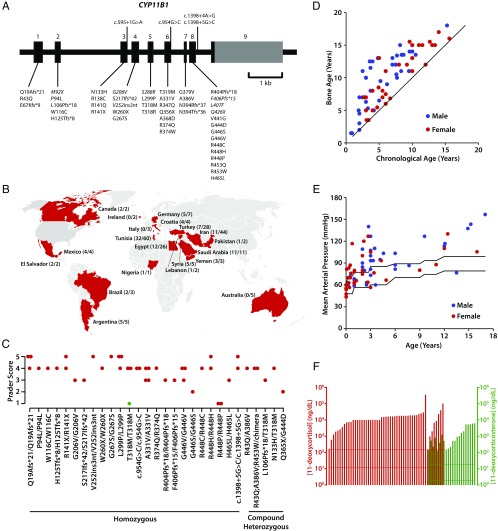Fig. 1.
Clinical profile for patients with CAH resulting from 11β-hydroxylase deficiency from 13 nations comprising the International Consortium for Rare Steroid Disorders. (A) Structure of the human CYP11B1 gene that contains nine exons, showing mutations harbored by 108 patients in this international cohort. Previously unreported mutations are shown in italics. (B) Worldwide distribution of our cases of 11β-hydroxylase deficiency. The denominator indicates the number of patients originating from that country with 11β-hydroxylase deficiency. The numerator indicates the number of patients with 11β-hydroxylase deficiency who have been genotyped. All patients who originated from Middle East and European countries have been placed in their respective countries. It is evident from this map that the majority of patients with 11β-hydroxylase deficiency originate in the Middle East and North Africa. (C) Prader scores of patients with different genotypes (noted), both as homozygotes and compound heterozygotes. One patient (green) has been treated prenatally with dexamethasone. (D) Bone age versus chronological age in male (blue) and female (red) patients. The black line represents a slope of 1 (bone age = chronological age). Of note is that almost all patients show evidence of advanced bone age. (E) Mean arterial pressure (1/3 systolic pressure + 2/3 diastolic pressure) shown for both males and female patients of various ages. The two lines indicate the age-appropriate upper and lower limits of the normal range. (F) Measurements of 11-deoxycortisol (red) and 11-deoxycorticosterone (green) in our patient cohort. Shown also are normal reference ranges for both hormones (horizontal lines; Esoterix).

